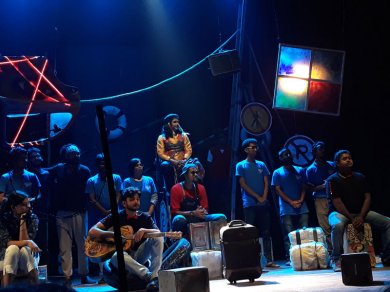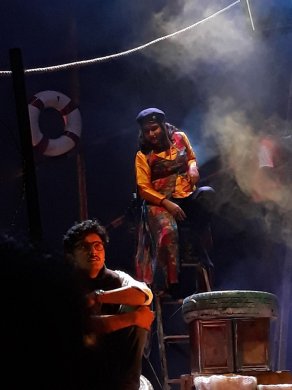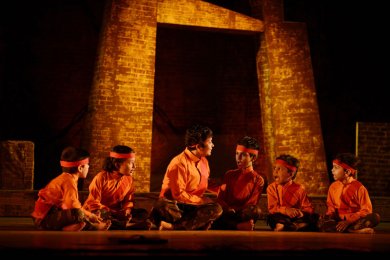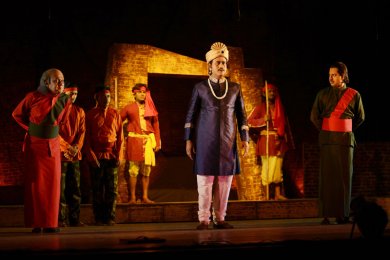
|   |

|   |
 e-mail: ukb7@rediffmail.com Dream and iconoclasm December 7, 2018 Mohit Chattopadhyay (1934-2012) was an avant garde dramatist in Bengali language and a poet, with over one hundred plays to his credit. Hailed as a Kimitibadi (one with the motto 'what is it?') playwright, because of the cryptic quality of his language, Mohit was critically admired for many milestone works in the history of Indian political drama produced with acclaim in Kolkata, Delhi and Mumbai.  Captain Hurrah Captain Hurrah presented on October 31 in Kolkata by 'Ichchhemoto' was penned in 1970. It reflected the playwright's foresight into Bengal's emerging political turmoil in the following decade and a sense of lost perspective for the rudderless ideologues, looking for directions "in the encircling gloom". The play begins innocuously with a stranded young couple's search for a night's shelter and soon their hotel's space turns out to be nothing but a highly symbolic "ship" or so viewed by its pilot, Captain Hurrah, who - along with his cohort Googloo - appears to be "steering" his craft through "unchartered seas" towards an unknown destination, for which they are desperately looking for the "map" for guidance. Their path is further beset by a "detective" also fishing for the "map" and the play heads towards a cataclysmic climax when the "ship" is about to be wrecked by invading "sea-pirates" also searching for the "map" apparently held by the distraught couple, completely unaware of their non-existent treasure!  Captain Hurrah One can imagine the mayhem that can result from such a scenario. While the mooning couple, Ira (Sulagna Nath) and Sunil (Apratim Sarkar), form a perfectly normal duo with totally realistic acting, Captain Hurrah (enacted with great aplomb by the gifted actress Turna Das) and the factotum Googloo (Shuvayan Ghosh) use very stylised movements and dialogues. The director Saurabh Palodhi pulls off a very credibly orchestrated performance from the disparately set characters, placed in a mise-en-scene that is crafted with an assortment of knick-knack, with sails and rudders, ropes and poles, and with even a 'dream chair' and a 'debate chair'! Extracts from an interview with the director: In "the Theatre of the Absurd", the situations are always illogical, characters speak paradoxical language, and events don't lead anywhere - as in Eugene Ionesco's Bald Prima Donna, Chairs, Rhinoceros; or Jean Genet's Maids; or Franz Kafka's Metamorphosis. Your play, on the other hand, is about a dream of political emancipation which is perfectly logical and natural. So, how have you called your play an "absurdist drama"? I disagree with you. The playwright himself had called the play "absurdist". Besides, here the hotel is viewed as a ship; everybody is looking for a map that does not exist in reality; the set is cluttered with bizarre furnishings. Are these elements not to be called absurd? But the dream is so palpably there... Yes, the Captain's eyes are full of a dream of a desired land where everybody is equal. The "neutral public" are inspired to join him; the "rulers" resist; yet the land beckons them where, as they sing: There's gold lying under the dug-up earth;, there's a sky full of free air as you breathe in; there's a sea of billowy waves as you look up... The quest for the map for this land is like a long-lasting struggle that is heralding them. In unison, they all stand on the deck of the Captain's ship dreaming of this land. As the ship sails away, even the "neutral" becomes politically committed, saying, "We've the map..." So, your play has a clear focus and is not at all nihilistic as are the Absurdist dramas... Look, mine is an out-and-out political play, with multiple sides of the main issue. It was relevant for the 1970s, and seems so even today! I'm completely apolitical myself, but I'm interested in the journey. How have you etched your characters? Ira and Sunil are completely neutral and are real flesh-and-blood, to whom I didn't give any character sketch or suggest any "method" acting. When they sit on the "dream chair" or the "debate chair", they go out of character and pick up a fight. The others are wholly stylised, are motivated in their own way, with the "map" (or absence of it) providing the focus, as you mention. You've used copiously Hindi songs... Yes, we chose them in a joint effort accordingly as they made sense in the situations being depicted. Any general comment? I was taught by my elders to view theatre as a "minority art". Unless it raises questions, its performance is meaningless. I want my audience to pause in their thinking, to quiz me as the director, and not go away merely having seen something trivial... 
 Achalayatan Apparently imaged after the Middle-Age monasteries in Europe with their cloistered band of priests, Tagore's seminal play Achalayatan (The Static Institution) conjures up a fortress like closed space somewhere around us, with staunchly hierarchical religious luminaries, overseeing a group of well-secluded novices, bent on learning only their decrepit scriptures and strictly observing decades old rites in every walk of life. Tagore spins his allegorical tale in this cooped up atmosphere, where a certain learner has inadvertently opened up a certain window closed ritually for ages and is being administered mind-boggling punishments; a novice is brewing revolt by neglecting to learn his dicta and hobnobbing with the free tribals roaming around outside the closed institution's precincts; and the chief priest has uneasy stirrings in his mind on whether such rigorous formalism has at all been worthwhile. The "erring" chief priest is promptly banished; the overall 'guru' of the sect is heralded to visit after a very long interval and, when he finally arrives, he is seen in a rebellious mood to take down the stagnating citadel -- by leading the tribals to break into it - and freeing the institution of its accumulated bindings. When Tagore wrote Achalayatan in 1912, his theme touched on two basic concepts: man's longing for freedom from the trappings of lifeless religious rituals and the abolition of invidious communities and castes as a pre-condition for social evolution. Though the subject matter involves an ideology that is archetypal in character, Tagore gave it an Indian orientation and thereby touched much more than a hornet's nest. Critics read into the play a stinging attack upon the orthodox Hindu society and dragged the poet into a virulent literary fray. In a spirited defence, Tagore asserted that it was a universal truth that human soul was arrested whenever rituals stifled the true religion. The satire on the ritual-ridden society was, however, only incidental to his own artistic expression of the anguish of the arrested soul. Tagore took great pains to point out that, in every country and in every age, someone had always appeared to apprise mankind that formalism was not true religion and that meaningless rituals did not lead to freedom, but only to bondage. Achalayatan presented on November 1 in Kolkata by 'PanchamVaidik' was a valiant effort to re-imagine this over-a-century-old oeuvre of Tagore and establish how it continues to be trenchantly relevant still and deserves to be fiercely debated. Directed proficiently by Arpita Ghosh - who also dons the delightfully tomboyish role of the young truant Panchak - the play goes on a roller-coaster ride on the pervading milieu of austerity and rigour in maintaining rites; the brewing revolt of the committed bunch of priests against Acharya (played superbly by Babu Dutta Roy); the innocent song-and-dance sequences of the tribals; and the metaphorical break-down of the stultifying superstructure to let in fresh air. The set showed a fresh approach, the lighting was adequate and the teamwork was well coordinated, including the bunch of mint fresh toddlers! Asked on the raison d'etre of staging an old play such as this, the director staunchly defends, "I've been observing, for a long time, an environment as imagined by Tagore where both our education and our political consciousness are reflective of a closed mind, as visualised in the play. Our religious organisations have been unable to nurture free thinking and we're victims of old prejudices every day. Self-confidence and liberal attitudes have yielded to dead practices, as though one must not ever question and as if all queries have been answered already! In the rat race of looking for the best bargain in everyday life, Achalayatan seems to be of burning relevance to me!" This critic would agree.  Dr. Utpal K Banerjee is a scholar-commentator on performing arts over last four decades. He has authored 23 books on Indian art and culture, and 10 on Tagore studies. He served IGNCA as National Project Director, was a Tagore Research Scholar and is recipient of Padma Shri. Post your comments Please provide your name and email id when you use the Anonymous profile in the blog to post a comment. All appropriate comments posted with name & email id in the blog will also be featured in the site. |